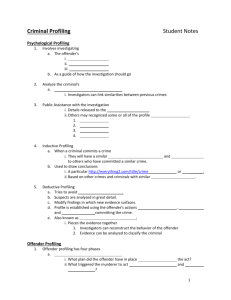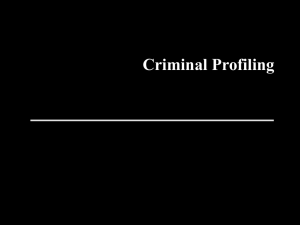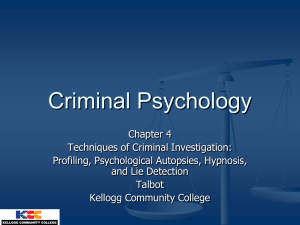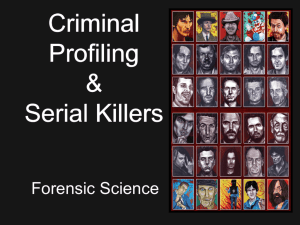fran detailed OP
advertisement
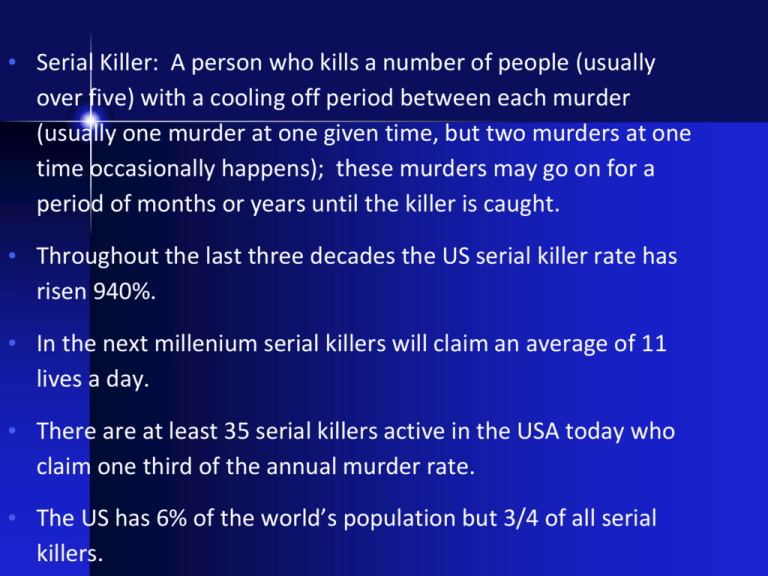
• Serial Killer: A person who kills a number of people (usually over five) with a cooling off period between each murder (usually one murder at one given time, but two murders at one time occasionally happens); these murders may go on for a period of months or years until the killer is caught. • Throughout the last three decades the US serial killer rate has risen 940%. • In the next millenium serial killers will claim an average of 11 lives a day. • There are at least 35 serial killers active in the USA today who claim one third of the annual murder rate. • The US has 6% of the world’s population but 3/4 of all serial killers. Criminal Profiling There a many types of profiling. FBI (VI-CAP), Investigative Psychology; Behavioural Analysis; Deductive & Inductive Method Criminal Profiling - Approaches • Top Down: F.B.I. Violent Offender Investigation Unit (former Behavioral Science Unit) • Bottom up: Investigative psychology & environmental Psychology (Canter et al.) Criminal Profiling • “The criminal personality profile is based on good crime scene examination and adequate information supplied to the profiler” Gerbeth 1996 • "an educated attempt to provide investigative agencies with specific information as to the type of individual who committed the crime" Gerbeth 1981 Criminal Profiling – Basic Aims • Primarily fact finding in the context of the duty to public safety in both the investigative and trial phase aims of the profiler will vary. • Investigation: reduce and prioritize suspect pool; assist in linking; assess potential for escalation; provide relevant leads and strategies; help focus the overall investigation. • Trial: assist evaluation of forensic evidence; assist in interview strategy; help gain insight into offender fantasy & motivation; insight into “states of mind” before during & after the crime [planning; precautions, remorse etc..] First Profile?: ‘Jack the Ripper’ • First known case of killer profiling-Dr. Thomas Bond examined the victim-Mary Kelly • Determined some personality traits of the killer from victim • Often considered the first recorded serial killer because of the nature of the crimes (a typical sexual motive). Dr. Bond, performed an autopsy on the last victim of the ‘Whitechapel Killer’. He noted that the killer must have had knowledge of surgical skills as many of the bodies were mutilated and internal organs were removed. He attempted to reconstruct the murder so discover the behaviour patterns of the killer. He then produced a profile on the murderer stating that he is a ‘harmless-looking and quiet man’ as well as ‘physically strong, composed and daring even though he was a loner with no real occupation.’ Jacob Fries (1773-1843) Enquires began. 2. Cesare Lombroso (1835-1909) Body type theorist 1. Alphonse Bertillon (1853-1914) Body type theorist 4. Hans Gross (1847-1915) Personality Theorist 3. Lombroso's & Kretschmer's Early Attempts at Profiling 1 An aquiline beak of a nose 2. Fleshy, swollen, or protruding lips 3. Small receding chin 4. Dark hair and bushy eyebrows that meet across the nose 5. Little or no beard 6. Displays an abundance of wrinkles 7. 4 to 5 times greater taste sensibility 8. A cynical attitude, completely lacking remorse 9. More likely to wear a tattoo 10. Attaches no importance to dress as is frequently dirty and shabby (Lombroso-Ferrero 1972) 1. Cycloid Personality -- heavyset, soft body type, vacillates between normality and abnormality, lacks spontaneity and sophistication, most likely to commit nonviolent property crime. 2. Schizoid Personality -- most likely to have athletic, muscular body; some can be thin and lean, schizophreniclike, commits violent types of offences 3. Displastic Personality -- mixed group, highly emotional, often unable to control self, mostly commits sexual offences or crimes of passion (Kretschmer 1925) The offices of OSS requested the help of Walter Langer to develop the profile of one Adolph Hitler he came with.... “If Hitler is running the show, what kind of person is he? What are his ambitions? How does he appear to the German people? What is he like with his associates? What is his background? And most of all, we want to know as much as possible about his psychological make-up, the things that make him tick. In addition, we ought to know what he might do if things begin to go against him." These were the words of Colonel William J Donovan. The result of the investigation established the psychodynamic personality profile that not only pointed out Hitler's oedipal complex in needing to prove his manhood to his mother, but also predicted that Hitler would commit suicide at war's end FBI – top down Crime scene data • Survey of 36 cases • Interviewed convicted serial offenders • Developed serial killer typology = ‘types’ profile • Later modified to 2 types • Organised and Disorganised FBI Profile: Organized • Show signs of planning and evidence of control at the crime scene • Offenders are • Intelligent • Socially skilled • Sexually competent • Live with a partner • Usually target strangers • Antisocial and psychopathic personality FBI’s Approach to Offender Profiling: Disorganized • Unplanned and disorganized behaviour & lack of control at the crime scene • Offenders are • Low intelligence • Socially and sexually inept • Live alone • Severe mental illness • Likely have been suffered from physical or sexual abuse as a child • Frightened or confused state of mind Typologies of Murder and Motive Willie (1974) Types • Depressive • Psychotic • organic brain • Disorder • Psychopathic • Passive aggressive • Alcoholic • Hysterical • Juvenile • Mentally retarded • sex killers Lee (1988) Motives • Profit • Passion • Hatred • Power / domination • Revenge • Opportunism • Fear • Contract killing • Desperation • Compassion FBI Psychological Profile of Lust Killers Organised Killer • intelligent • high birth order • masculine image • charismatic • socially capable • sexually capable • occupationally mobile • lives with partner • geographically mobile • experienced harsh • childhood discipline • controlled emotions • interested in media • model inmate Dis-organised Killer • below average IQ • low birth order • socially immature • seldom dates • high school failure • unemployed father • lives alone • has secret hiding places • nocturnal • lives/works near crime • unskilled worker • behaviour change • low interest in media • little alcohol consumption • high anxiety during crime 16 Basic Typology A specific victims B variety of victims specific methods specific methods C specific victims D variety of victims variety of methods variety of methods Diagnosing psychotic personalities • DSM and ICD are the two classification manuals used by psychiatrists to diagnoses mental illness. • It is now possible to identify certain personality disorders that are associated with criminal propensities. Anti-social Personality Disorder DSM - IVR: Diagnostic criteria A. There is a pervasive pattern of disregard for and violation of the rights of others occurring since age 15, as indicated by 3 or more of the following1. Failure to conform to social norms with respect to lawful behaviours as indicated by repeatedly performing acts that are grounds for arrest 2. Deceitfulness, as indicated by repeated lying, use of aliases, or conning others for personal profit or pleasure 3. Impulsivity or failure to plan ahead Anti-social Personality Disorder DSM-IVR: Diagnostic criteria II 4. Irritability and aggressiveness, as indicated by repeated physical fights or assaults 5. Reckless disregard for the safety of self or others 6. Consistent irresponsibility, as indicated by repeated failure to sustain consistent work behaviour or honour financial obligations 7. Lack of remorse , as indicated by being indifferent to or rationalising having hurt, mistreated, or stolen from another. Hare’s Psychopathy Checklist (PCL) Factor 1: Measures of selfish, callous & remorseless use of others & includes most of the personality characteristics of the traditional clinical concept of the disorder - traits are inferred rather than explicit. • Glibness/superficial charm • Grandiose sense of self-worth/narcissism • Pathological lying & deception • Conning (insincere), manipulative behaviour • Lack of remorse or guilt • Shallow affect • Callousness/lack of empathy • Failure to accept responsibility for actions Psychopathy Checklist (PCL) 3 Other Factors: • Promiscuous sexual behaviour • Many short-term marital relations • Criminal versatility • Drug & alcohol not direct cause of antisocial behaviour Cleckley’s (1962) “The Mask of Insanity” -machine man & insensitivity may have physiological origins Psychopathy Checklist (PCL) 2 Factor 2: Measures social deviance manifest as a chronically unstable & anti-social lifestyle - more explicit than Factor 1. • • • • • • • • • Need for stimulation/prone to boredom Parasitic lifestyle/behaviour Poor behavioural controls Early behavioural problems Lack of realistic long-term goals Impulsivity Irresponsible Juvenile delinquency/criminal record Revocation of conditional release or supervision Psychopathy Vs Reactive Offender PSYCHOPATH Self-concept: Invulnerable Superior Pre-emptive rights Sees Others: Dupes/stupid Inferior Weak Strategies: Manipulative Violence Assumptions of British Profiling • The crime scene reflects the personality • The methods remain similar • The signature remains the same • The personality will not change Four Stages of Crime: Serial Killers 1. Pre-crime Stage 2. Actual commission of crime 3. Disposal of body 4. Post-crime behavior Assessment :Organized or Disorganized David Canter’s Approach Assumes - offfender’s actions at the crime scene can reveal information about his background • Bottom up approach • Interpersonal Coherence • Significance of time and place • Criminal Characteristics • Criminal Career • Forensic Awareness Canter: Five Factors 1. Residential location 2. Criminal biography 3. Domestic / Social characteristics 4. Personal characteristics 5. Occupational / Educational history Three methods: Facet Theory, Smallest Space Analysis (SSA) & Circle Hypothesis of Environmental Range MO, Signature & Motivation Signature - a pattern of distinctive behaviors that are characteristic of and satisfy general emotional and psychological needs. Generally the fall into themes: • profit • anger/retaliation • reassurance/experimentation • assertiveness • sadism [anger excitation]. Signature behaviours - those acts done by the offender which are not essential to the crime - they suggest some special need of the offender. MO, Signature & Motivation MO & Signature difficult to distinguish because they may overlap - offenders do the same thing for different reasons MO that enable successful completion [protect ID, ensures success & enable escape] include: • planning, • selection, • pre-surveillance, • weapons & constraints, • precautions, • transportation etc. MO, Signature & Motivation MO evolves and devolves & is influenced by: • general knowledge • trade & professional experience • prior criminal experience & confidence • prior contact with the CJS • the media, offender moods, and • X factors [unpredictable events which alter MO]. Victimology – the next wave of profiling • Victim profiles help provide context, connections & investigative direction. “What are the offender needs that victim selection satisfies” Turvey 1999 Victimology • • • • • Create a time-line to determine the point at which the offender acquired the victim: Place he/she attacked the victim; Visibility of the attack location & need for familiarity; was victim acquisition dependent on a routine or schedule & indicative of surveillance? Does the route/place of acquisition put the victim [or the offender] at high or low risk? Investigate the obvious - examine all connections & relationships - especially the first [if known] crime. Your turn……
